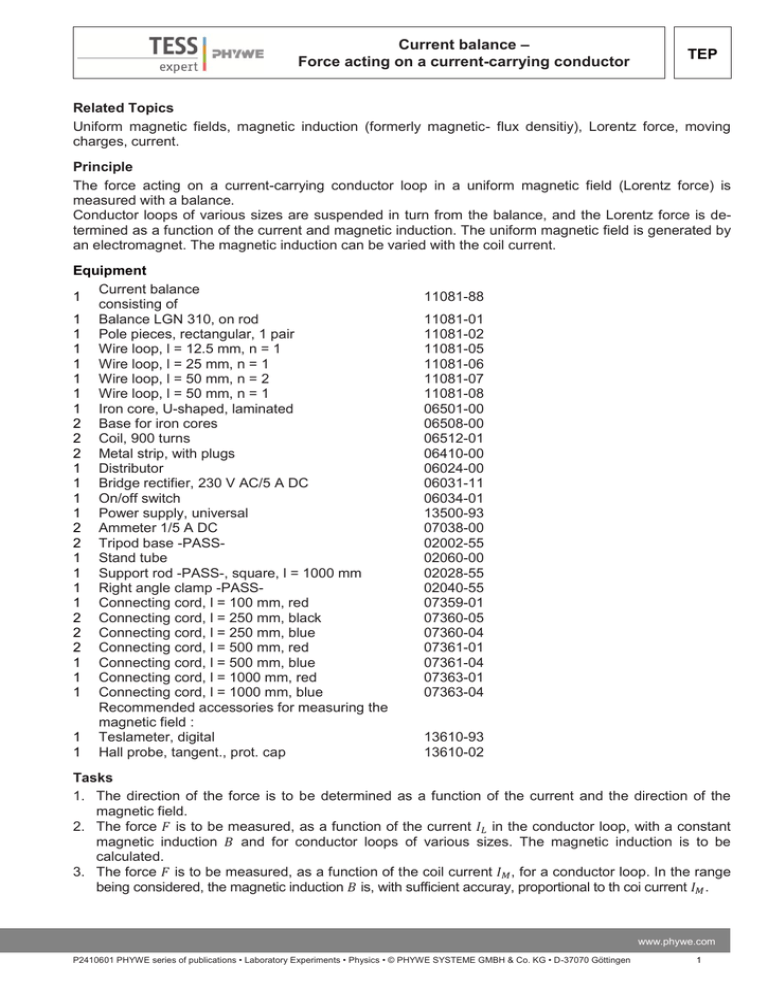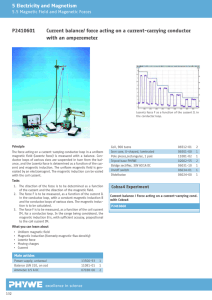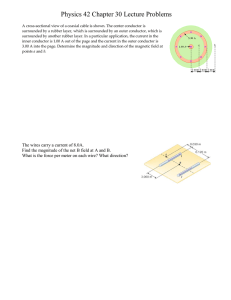TEP Current balance – Force acting on a current-carrying
advertisement

Current balance – Force acting on a current-carrying conductor TEP Related Topics Uniform magnetic fields, magnetic induction (formerly magnetic- flux densitiy), Lorentz force, moving charges, current. Principle The force acting on a current-carrying conductor loop in a uniform magnetic field (Lorentz force) is measured with a balance. Conductor loops of various sizes are suspended in turn from the balance, and the Lorentz force is determined as a function of the current and magnetic induction. The uniform magnetic field is generated by an electromagnet. The magnetic induction can be varied with the coil current. Equipment Current balance 1 consisting of 1 Balance LGN 310, on rod 1 Pole pieces, rectangular, 1 pair 1 Wire loop, l = 12.5 mm, n = 1 1 Wire loop, l = 25 mm, n = 1 1 Wire loop, l = 50 mm, n = 2 1 Wire loop, l = 50 mm, n = 1 1 Iron core, U-shaped, laminated 2 Base for iron cores 2 Coil, 900 turns 2 Metal strip, with plugs 1 Distributor 1 Bridge rectifier, 230 V AC/5 A DC 1 On/off switch 1 Power supply, universal 2 Ammeter 1/5 A DC 2 Tripod base -PASS1 Stand tube 1 Support rod -PASS-, square, l = 1000 mm 1 Right angle clamp -PASS1 Connecting cord, l = 100 mm, red 2 Connecting cord, l = 250 mm, black 2 Connecting cord, l = 250 mm, blue 2 Connecting cord, l = 500 mm, red 1 Connecting cord, l = 500 mm, blue 1 Connecting cord, l = 1000 mm, red 1 Connecting cord, l = 1000 mm, blue Recommended accessories for measuring the magnetic field : 1 Teslameter, digital 1 Hall probe, tangent., prot. cap 11081-88 11081-01 11081-02 11081-05 11081-06 11081-07 11081-08 06501-00 06508-00 06512-01 06410-00 06024-00 06031-11 06034-01 13500-93 07038-00 02002-55 02060-00 02028-55 02040-55 07359-01 07360-05 07360-04 07361-01 07361-04 07363-01 07363-04 13610-93 13610-02 Tasks 1. The direction of the force is to be determined as a function of the current and the direction of the magnetic field. 2. The force is to be measured, as a function of the current in the conductor loop, with a constant magnetic induction and for conductor loops of various sizes. The magnetic induction is to be calculated. 3. The force is to be measured, as a function of the coil current , for a conductor loop. In the range being considered, the magnetic induction is, with sufficient accuray, proportional to th coi current . www.phywe.com P2410601 PHYWE series of publications • Laboratory Experiments • Physics • © PHYWE SYSTEME GMBH & Co. KG • D-37070 Göttingen 1 TEP Current balance – Force acting on a current-carrying conductor Fig. 1: Experimental set-up: Current balance. Force acting on a currentcarrying conductor. Note If a magnetic-field measuring instrument is available, then, in the third of the above tasks, the Lorentz force can be measured directly as a function of the magnetic induction. Set-up and procedure The experiment is set up as in Fig. 1. The coils of the electromagnet are connected in series and are connected to the alternating voltage output of the power unit via an ammeter, a switch and a bridge rectifier. For the first two parts of the experiment, a fixed voltage of 12 V AC is selected and the associated current in the coils is measured. The conductor loops are connected via two light flexible metal stripes, first of all to a distributor, and then via an ammeter to the direct voltage output of the supply unit. The distance between the metal strips should be as large as possible and they should only sag slightly, so that no forces from the magnetic field act on them. 2 P2410601 PHYWE series of publications • Laboratory Experiments • Physics • © PHYWE SYSTEME GMBH & Co. KG • D-37070 Göttingen Current balance – Force acting on a current-carrying conductor TEP 1. The pole shoes are first placed on the electromagnets in such a way as to produce an air gap of about 4 cm. The conductor loop with = 25 mm is suspended from the balance with its horizontal section perpendicular to the lines of the magnetic field. The balance is trimmed with no current flowing through the conductor, and a conductor current of is then set. The direction and magnitude of the force are determined as a function of the direction of the current and are observed with the magnet rotated about a horizontal axis. Without a magnetic field, the position of the balance is observed both with and without current flowing through the conductor loop. 2. The pole shoes are placed on the electromagnet with their edges parallel and with an air gap of 1 cm. The conductor loop with = 12.5 mm is hung on the balance. The horizontal section of the conductor runs perpendicular to the field lines and – with the balance trimmed – is in the middle of the uniform field (fine adjustment with screw on tripod). The current in the conductor is raised in steps of 0.5 A with the knob on the power unit. The mass of the conductor loops is determined with the magnetic field switched off. The magnetic field is then switched on, the (apparently increased) mass is measured, and the Lorentz force calculated from the difference between the two readings. The measurement is made in a similar way for the other three conductor loops. 3. The procedure is essentially as described in 2 above, only with conductor loop = 50 mm, = 2. The current in the conductor is = 5 A. The current in the coils is varied by means of the applied voltage. The Lorentz force on each occasion is determined from the readings. Fig. 2: Lorentz force as a function of the current in the conductor loop. Parameter: lenght Coil current = 870 mA. www.phywe.com P2410601 PHYWE series of publications • Laboratory Experiments • Physics • © PHYWE SYSTEME GMBH & Co. KG • D-37070 Göttingen 3 Current balance – Force acting on a current-carrying conductor TEP Theory and evaluation In a magnetic field with a magnetic induction , a force with charge and velocity : (Lorentz force) acts on a moving charge carrier . (1) The force vector is perpendicular to the plane occupied by and . In this experiment and are also at right angles to each other, so that the following relationship holds for the values of the vectors: . (2) The velocity of the charge carriers (electrons) is measured via the electric current in the conductor. The total charge of the electrons in the section of the conductor of length must be formulated for : . (3) . (4) The following is therefore obtained for the Lorentz force: 1. Observations show that the direction of the force vector is dependent on the direction of travel of the electrons and the direction of the magnetic field. In the field lines are parallel to the direction of travel, a force acts on the conductor loops. At a magnetic induction of = 0, the balance changes its position only slightly when the current in the conductor loop is switched on. At = 5 A, however, the change in the force is quite measureable. The explantation of this effect is that two conductors carrying a current are mutually attracted. When a current flows, the flexible metal strips change their position slightly and can thereby affect the position of the balance. 2. In the two vertical sections of the conductor loop the electrons travel in opposite directions, and the two forces acting on them cancel each other out. Only the horizontal section of the conductor loop, whose lenght is indicated on each occasion on the loop, therefore affects the measured Lorentz force. One of the conductor loops has two turns ( = 2), each with a horizontal lenght of 50 mm. The Lorentz force on these conductor loops is exactly equivalent to that on a single loop of twice the lenght ( = 100 mm, = 1). The experimental results are shown in Fig. 2, where . Using the respective parameter, the value of the magnetic induction slope of the regression line in Fig. 2 with a standard deviation : Conductor loop = 184 mT, Conductor loop = 173 mT, Conductor loop = 168 mT, Conductor loop = 164 mT, 4 can be obtained from the = 12.5 mm = 1 mT = 25 mm = 1 mT = 50 mm = 1 mT = 100 mm = 1 mT. P2410601 PHYWE series of publications • Laboratory Experiments • Physics • © PHYWE SYSTEME GMBH & Co. KG • D-37070 Göttingen Current balance – Force acting on a current-carrying conductor Fig. 3: Lorentz force as a function of the conductor lenght for TEP = 5 A. Coil current 870 mA. The small value of the standard deviation indicates that the measured values fit nicely on a straight line. The scatter of the values determined for the magnetic induction is due to the stray field at the edge of the uniform magnetic field, which exerts forces on the horizontal part of the leads to the conductor loop. Their effect is greater with short conductor loops than with long ones, since the Lorentz forces measured are small. In Fig. 3 the Lorentz force F for a fixed current = 5 A is plotted against the conductor length . We obtain: . As a result of the influence of the stray field described above, the linear graph in Fig. 3 does not pass exactly through the origin. www.phywe.com P2410601 PHYWE series of publications • Laboratory Experiments • Physics • © PHYWE SYSTEME GMBH & Co. KG • D-37070 Göttingen 5 Current balance – Force acting on a current-carrying conductor TEP 3. The experimental results are shown in Fig. 4. The Lorentz force the coils of the electromagnet: Fig. 4: Lorentz force as a function of current is proportional to the current in in the coils for conductor loop = 100 mm. Note If a magnetic-field measuring instrument is available, the magnetic induction can be measured as a function of the coil current. The measurements show that the magnetic induction and the coil current are proportional in the range under consideration. Together with the results from Fig. 4, we therefore obtain . With a coil current of = 870 mA, the magnetic induction in the 1 cm air gap is = 168 mT, in good agreement with the values calculated from the slope of the regression lines in Fig. 2. 6 P2410601 PHYWE series of publications • Laboratory Experiments • Physics • © PHYWE SYSTEME GMBH & Co. KG • D-37070 Göttingen



